User manual

iDISPLAY TABLET
User Manual

1
Table of Contents
About This Guide 2
Introducing the iDISPLAY 2
Important Notices 3
Copyright Information 3
Safety and Warning Information 4
Package Contents 5
Quick Start User Guide 7
Setting up the Tablet Hardware 7
Playing Videos and Displaying Images 7
Supported File Formats 8
Accessing the Pulse Player Settings 8
Pulse Player Settings 9
Using the Android Operating System 13
Configuring the Android Operating System Settings 14
Using Pulse Management 15
Troubleshooting 16
2
About This Guide
Thank you for purchasing an Outform product. We recommend reading this user guide
in its entirety in order to maximize the performance and service life of this product. This
product is intended for commercial use and should be installed by authorized personnel
only.
Introducing the iDISPLAY
The iDISPLAY are interactive digital displays designed to be used in commercial
environments, and includes the following features:
•Quad core processor
•1920 x 1080 full HD resolution
•Android 4.4 operating system
•10-point touch capacitive screen
•802.11b/g/n WiFi
•Bluetooth
•VESA wall mounting option
•100M/1000M RJ45 Ethernet port with Power over Ethernet
•USB ports
•2 speakers
•Headphone jack
If required, please ask for detailed specifications.

3
Important Notices
Copyright Information
Copyright © 2016 Outform. All rights reserved.
All intellectual property rights in this publication are owned by Outform and protected
by applicable copyright laws and international treaty provisions. Outform retains all
rights not expressly granted. No part of this publication may be reproduced in any form
whatsoever or used to make any derivative work without prior written approval by
Outform.
Outform reserves the right to revise this publication, and/or make improvements or
changes in the product(s) and/or the program(s) described in this documentation at
any time without prior notice. The information in this document is provided in good
faith, but without any representation or warranty whatsoever, whether it is accurate,
or complete or otherwise, and on express understanding that Outform shall have
no liability whatsoever to other parties in any way arising from or relating to the
information or its use.
All other trademarks are the property of their respective owners. Other company and
brand products and service names are trademarks or registered trademarks of their
respective holders.
This device complies with CE and FCC regulations.

4
Safety and Warning Information
NOTE
This mark is applied to indicate that the equipment conforms to European safety and
electro-magnetic compatibility standards.
WARNING!
Main Supply: This equipment is designed to operate from a 100-240 Volt, 50/60Hz AC
power supply. The use of other power sources may damage this equipment. Check that
the voltage marked on the rating plate located at the rear of the power adaptor states
100-240V. The manufacturer will NOT accept responsibility or damage or injury caused
by connecting to the wrong voltage.
WARNING!
Main Adaptor: The supplied power adaptor is compatible with a standard main socket.
If the power adaptor or lead gets damaged, it must be replaced by a qualified service
agent with an approved adaptor of the same type and rating.
WARNING!
Dangerous voltage constituting a risk of electric shock is present inside this equipment.
WARNINGS!
The main plug shall be the main disconnect device and shall remain operable at all
times.
Do not push objects into holes and ventilation slots.
Do not expose this product to moisture or place any objects filled with liquids on or
near the product.
Do not place a naked flame source, such as lighted candles, on or near this product.
Do not store or operate the device in environments where the temperature is above 50
degrees celsius or below -10 degrees celsius.
Do not intentionally hit the device or place heavy or sharp objects on the device.
Only use accessories specified by the manufacturer.
Keep the device away from benzene, diluents, and other chemicals.
Do not attempt to repair this product yourself. Always use a qualified service agent to
perform adjustments or repairs.

5
Package Contents
The package contains the following items:
Display Tablet
Power Adapter Power Cable
(US, UK, or EU)
USB Mini Mouse
(Included with advertising
displays only)
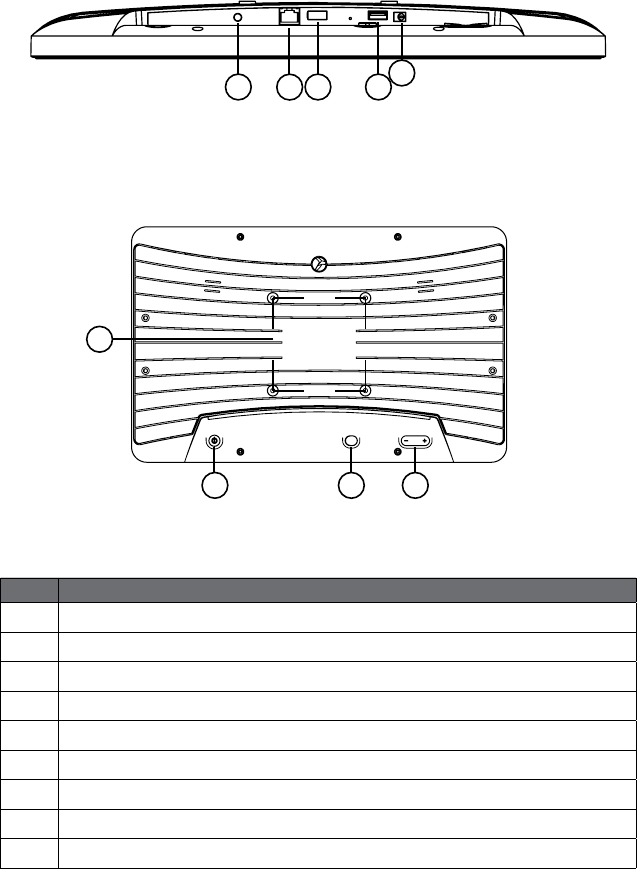
6
Display Exterior Components
No. Description
1 3.5mm audio jack
2 RJ45 Ethernet jack with Power over Ethernet
3 USB 2.0 host port
4 USB 2.0 OTG port
5 DC in power supply port
6 VESA 100mm x 100mm mounting bracket screw holes
7 Power button
8 Back button
9 Volume control
Bottom View
2
1 43
Rear View
6
5
7 8 9
7
Quick Start User Guide
This section describes how to set up and use the iDISPLAY tablet for the first time. The
tablet runs OUTFORM’s Pulse Player software by default, which runs on an Android
operating system installed in the player to play the desired content.
Setting up the Tablet Hardware
Connect the following components to the back side ports of the iDISPLAY tablet:
•The power adapter, plugged in to a nearby plug outlet.
•Alternately, power may be supplied through the RJ45 outlet by plugging in an
RJ45 cable connected to a POE capable source.
The tablet automatically powers on and initiates the Pulse Player software, which in
most cases plays a sample video by default.
Playing Videos and Displaying Images
Copy video and image files to the tablet using a USB thumb drive as follows:
1. Insert an empty USB drive into a computer and create a folder titled “0” (the
number zero) at the topmost (root) directory of the drive. Ensure that no other
content is on the drive.
2. Copy the desired video and image files to be played into the “0” folder.
3. Eject the drive from the computer and insert it into a USB port on the back side of
the tablet.
4. A password prompt appears on the display. Enter the configured password using
the on-screen keyboard. By default this password is “11223344” without the
quotation marks, and can be modified later.
5. Upon successful entry of the password, select one of the two options that display,
either to delete and replace the existing content on the tablet or to simply add
additional content.
NOTE: If you choose to keep the existing content, the new content from the USB
drive is copied alongside the existing content, and no files are deleted. However, if a
file on the drive has the same name as a file already on the tablet, the file on
the tablet will be overwritten.
6. After a message displays indicating that the content has been copied, the USB drive
can be removed. The new content plays automatically.
NOTE: When auto-copying files from a Linux or MAC OS-based computer, hidden
metadata files, preceded by a period “.”, may also get copied into the “0” folder on the
USB drive. When Pulse Player attempts to play or display these files, a black screen is
shown momentarily. Use the Explorer app mentioned in the Android Operating System

8
Settings section below to manually delete these metadata files from the “0” folder on
the device.
Supported File Formats
The tablet supports the following file formats:
• Standard Android applications (APK files) supported by Android 4.0 and more
recent versions
• Video formats: 3gp / mp4 / avi / mkv / flv / mov / rm / rmvb
• Image formats: jpg / jpeg / png / bmp
Accessing the Pulse Player Settings
When content is being played on the display, use a finger to draw a Z shape on the
screen. Start at the top left of the screen and move in the direction shown below.
Note: If the tablet is an advertising display with no touch screen, plug the provided
mouse into a usb port on the tablet. Click and drag the mouse to draw the Z-shape and
interact with the tablet menus.
Then enter the configured or default password (“11223344” without the quotation
marks) when prompted to open the Pulse Player settings interface.
Modify the “Change Password” Pulse Player software setting to configure the password
for this function.
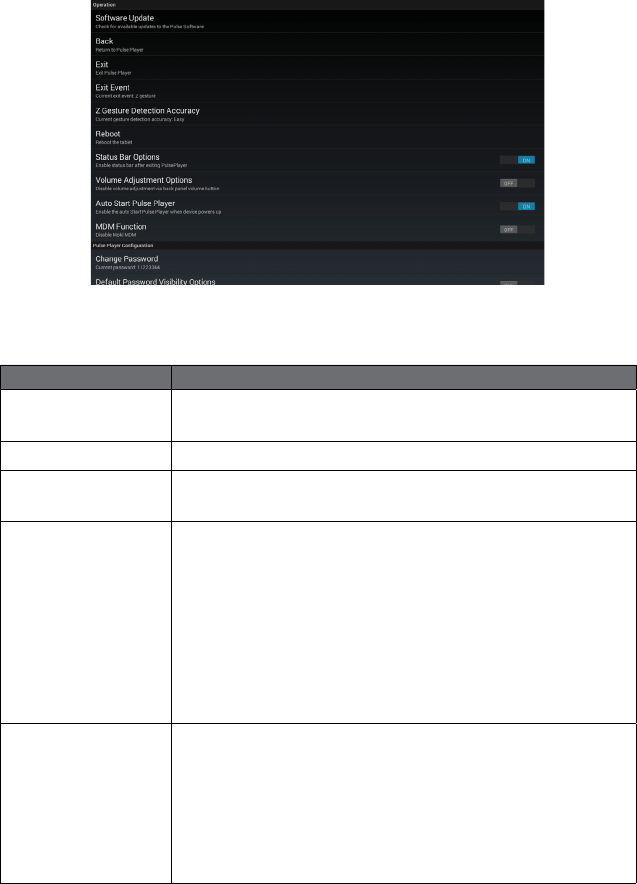
9
Pulse Player Settings
The following table describes the Pulse Player settings. For more information on how to
use the underlying Android operating system, refer to the following section.
Setting Description
Software Update Check for available Pulse Player software updates. This
requires an Internet connection.
Back Return to playing the configured content.
Exit Exit Pulse Player and open the home screen of the base
Android operating system.
Exit Event Configure how the user stops content playback to open the
Pulse Player settings interface. Settings include the following:
• Z gesture: Draw a large Z shape on the screen by sliding
a finger across the screen, starting at the top left of the
screen.
• Tapping the screen 5 times: Tap anywhere on the screen
5 times.
• Z gesture and tapping the screen 5 times: Either draw a Z
shape or tap 5 times as described above.
Z Gesture
Detection Accuracy
Choose “Easy”, “Medium, or “Hard” to configure how
accurately the user must draw the Z shape to perform the
Exit Event. “Easy” indicates a low level of drawing accuracy,
“Medium” a fair amount of accuracy, and “Hard” a stricter
level of accuracy, all with regards to how straight the lines of
the Z shape are drawn and whether the drawing is oriented
correctly.

10
Setting Description
Reboot Reboot the tablet.
Status Bar Option Show and hide the Android operating system quick launch
status and tool bar that appears at the bottom of the screen
after exiting Pulse Player. “ON” shows the status bar, while
“OFF” hides it.
Volume
Adjustment
Option
Enable and disable volume adjustment buttons on the
exterior of the Pulse Player device. “ON” means the buttons
are enabled, while “OFF” indicates that the buttons are
disabled. Note that this option only works for iDISPLAY
tablets, and does not aect the use of the media player set-
top box.
Auto Start Pulse
Player
Enable and disable running Pulse Player automatically when
the device powers on. “ON” indicates to automatically run
Pulse Player, whereas “OFF” does not, instead configuring
the device to load the Android operating system home page
when the system powers on.
MDM Function Enable and disable the Pulse Management software to
remote control iDISPLAY devices.
Change Password Select this setting to modify the configured password used to
perform administrative tasks related to Pulse Player.
Default Password
Visibility Option
Show (“ON”) or hide (“OFF”) the configured default
password in the password entry field.
Password
Validation Feature
Option
Enable (“ON”) or disable (“OFF”) option to password restrict
administrative tasks related to Pulse Player.
Image Interval Time Adjust the length of time (in seconds) an image or picture
is displayed before displaying the next image or video. The
configured time value can be within the range of 2 – 600
seconds.
Video Ratio
Option
“ON” indicates keeping the original video and image size ratio
when being played or displayed, whereas “OFF” indicates
resizing content to fit the screen.
Player Orientation
Option
“ON” enables automatic screen orientation recognition based
on how the device is positioned, enabling the portrait display
orientation. “OFF” keeps the screen oriented in the default
landscape display orientation. Note that this option only
works for iDISPLAY tablets, and does not aect the use of the
media player set-top box.

11
Setting Description
Log Option “ON” enables recording Pulse Player log messages to a log
file stored in the internal device memory. If this setting is
enabled, the log file “PulsePlayer_Log.txt” is created and
stored in the top-most directory of the device’s internal
memory, which can be accessed through the “Explorer”
Android operating system app.
Forward To Option Enable (“ON”) and disable (“OFF”) a “forward event”
initiation, such as opening a configured webpage (caused
by the user tapping the screen when content is playing).
When enabled, specific settings related to the event display
immediately below this setting.
Forward Target(TP
Folder/URL)
Shown when the “Forward To Options” setting is enabled.
Options include either specifying a URL to which the user is
forwarded, opening the Pulse Player web browser, which also
enables the “Set URL” setting (see this setting’s description
below), or “TP Folder”, which causes an event configured by
content, such as a web page file, stored in the “tp” folder to
be opened or played. TP folder content must be loaded into
the device’s top-level internal memory directory for the “TP
Folder” forward target setting to work.
Set URL Shown when the “Forward To Options” setting is enabled
and configurable when the “Forward Target(TP Folder/URL)”
setting is set to “URL”. Select this setting to specify a forward
event URL. Do not include “http://” at the beginning of the
URL.
Inactivity Time-out The length of time (in seconds) it takes for a password
input field or forward event webpage to time-out. The value
specified must be a value between 15 and 600 seconds. In
the case of a password input field, once the inactivity time
is reached, the field disappears and the content continues
playing. In the case of a URL forward event, this amount of
time specifies when a warning dialog pops up prompting
the user to stay on the page or return to the initially playing
content.
Warning Dialog
Expire Time
The length of time (in seconds) from which the forward
event webpage inactivity time-out warning dialog appears
until Pulse Player returns to playing the initially configured
video or image content. The value specified must be a value
between 3 and 600 seconds.
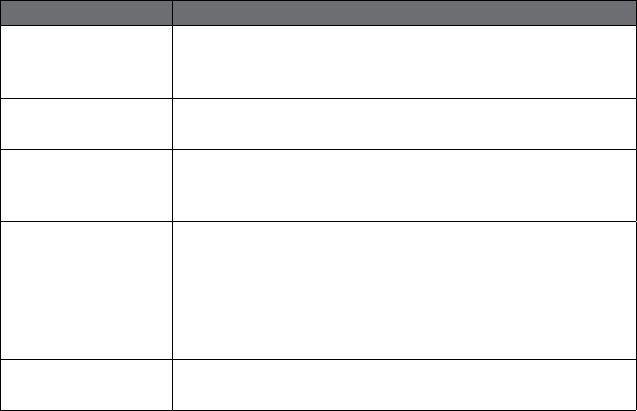
12
Setting Description
Hardware
Acceleration
Option
Enable (“ON”) or disable (“OFF”) hardware acceleration for
better video playback performance, if needed.
Progress Box
Option
Display (“ON”) or hide (“OFF”) an animated loading progress
icon when loading a forward event URL.
Cache Clear Option When enabled the forward to browser Cache and cookies are
cleared on exit from the Pulse Player. When disabled the Web
browser cache and cookies are kept.
Reboot Scheduler Configure a daily reboot time to ensure Pulse Player and the
underlying Android operating system memory is regularly
cleared and refreshed so as to maintain good playback
performance for extended periods of time. OUTFORM
recommends scheduling a daily reboot time when no
customers are expected to use the device.
Reboot On Error Turn this setting on to automatically reboot the device if
Pulse Player detects an error.
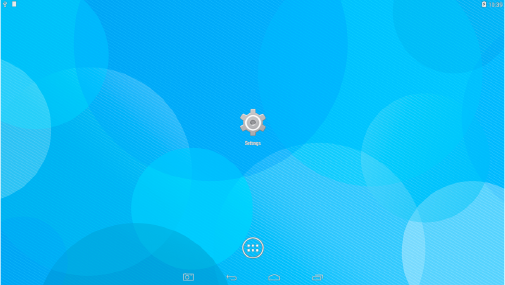
13
Using the Android Operating System
This section describes parts of the underlying Android operating system that are
relevant to using Pulse Player on OUTFORM devices. More important interface
elements are described below:
Applications Menu
On the bottom or side of the Android home screen, which by default has a light
blue background with scattered lighter colored circles, the applications menu can be
accessed by tapping on the white circular icon with six white smaller squares. The
applications menu contains commonly used Android applications and tools.
The following three applications most relevant to using your iDISPLAY device are
described below:
PulsePlayer
Opens and runs the Pulse Player software to play interactive content.
Explorer
A file and folder system management application. Use Explorer to manually manage
files to be played by Pulse Player (located in the “0” and “TP” folders, if present), as well
as to access other system-specific files such as the Pulse Player log file.
Settings
Configure the Android operating system settings, such as to turn on and connect to a
wireless network. The following section describes these settings more in-depth.
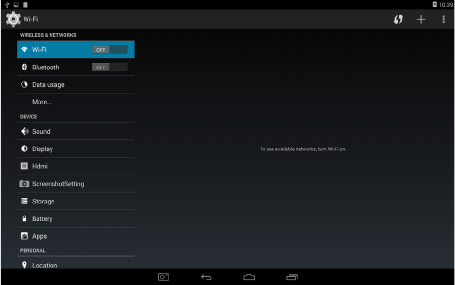
14
Configuring the Android Operating System Settings
Tap on the “Settings” icon to configure the following three relevant Android system
settings:
Connecting to a Wireless Network
The preselected item on the left hand settings menu is “Wi-Fi”. To enable wireless
connections, drag the “Wi-Fi” menu item slider to the right to display “ON”. After a
few seconds available wireless networks appear on the right side of the screen. Select a
network to configure and connect to it.
Connecting to a Wired Network
A wired connection may be made using a USB to Ethernet adapter. Select “More…” on
the Android settings left hand menu. On the menu to the right, select “Ethernet” and
ensure “Use Ethernet” is checked. Immediately below the “Use Ethernet” option, open
“Static IP Settings” to configure your network’s wired connection settings.
Enable USB Debugging
This setting allows developers to debug their applications. Select “Developer options”
on the left hand menu and then ensure “USB debugging” on the right is checked. Under
the “Device” section on the left side menu, “USB” and then “Connect to PC” also needs
to be enabled.
15
Using Pulse Management
Pulse Management is an additional subscription-based feature that can be used
to remotely control iDISPLAY devices. When connecting to the Internet, the Pulse
Management app automatically connects to the service’s servers, as is indicated by
the “Registering Device” message that briefly appears. If connecting to the Internet
for the first time, a prompt appears requesting device administrator activation. As
Pulse Management is intended to run in the background regardless of whether your
organization has registered for a Pulse Management account, select “Activate”.
Note that the Pulse Management app icon is present in the Android app menu, but
serves no function other than to indicate that the app has been installed. Tapping on
the app icon simply runs the software in the background without displaying any visual
messages or confirmations.
The service can be enabled and disabled by adjusting the “MDM Function” setting in the
Pulse Player settings menu.
Contact OUTFORM for help in setting up the Pulse Management service.
16
Troubleshooting
The following section lists common questions and troubleshooting scenarios.
When the Pulse Player forward to URL option is enabled, why does the
configured website not appear when I tap the screen?
Two possible reasons are explained below:
• The device is not connected to the Internet. Refer to “Configuring the Android
Operating System Settings” above.
• Ensure the configured URL is correct in the Pulse Player settings. Also, do not
include “http://” at the beginning of the URL.
When I insert a USB drive into my iDISPLAY device, the system does not
automatically prompt me to load my content onto the device.
Check the following:
• Ensure Pulse Player is running.
• Unplug and reinsert the USB drive to ensure the drive is connected properly.
• Ensure content to be played on the device is stored in a folder named “0” (the
number zero), and that this folder is located at the top-most (root) directory of the
USB drive.
• Use your computer to check if the USB drive contains an error. View your
computer’s operating system documentation to troubleshoot any problems related
to the USB drive.
• The USB drive was inserted into the “USB OTG (On-The-Go)” port of the iDISPLAY
device with the Android system “Developer options” setting “USB debugging”
enabled. The “USB OTG” port can also be used for developer debugging purposes.
If the “USB debugging” setting is enabled, only the “USB” port can be used to load
content onto the device. To use the “USB OTG” port, disable “USB debugging”.
What is the default Pulse Player password?
The default password is “11223344” without the quotation marks.
Why does my device reboot multiple times when I auto-copy data from my USB
drive?
This happens when an unsupported/corrupt file is copied to the device. Pulse Player
has a built-in auto recovery program that reboots the device a minimum of 5 times
to protect the software configuration. After rebooting a number of times, a prompt
appears requesting to delete the currently loaded content. Select “Yes” and enter
your password. The content stored in the “0” folder on the device is deleted. Double-
check the files on your computer to fix any problems related to the files, recopy the
desired content to the USB drive from your computer, and then perform the auto-copy
procedure a second time.

For additional assistance, visit outformsupport.com.
FCC Statement:
This device complies with part 15 of the FCC Rules. Operation is subject to the following
two conditions: (1) This device may not cause harmful interference, and (2) this device
must accept any interference received, including interference that may cause undesired
operation.
This equipment has been tested and found to comply with the limits for a Class B digital
device, pursuant to part 15 of the FCC Rules. These limits are designed to provide
reasonable protection against harmful interference in a residential installation. This
equipment generates, uses and can radiate radio frequency energy and, if not installed
and used in accordance with the instructions, may cause harmful interference to radio
communications. However, there is no guarantee that interference will not occur in a
particular installation. If this equipment does cause harmful interference to radio or
television reception, which can be determined by turning the equipment off and on, the
user is encouraged to try to correct the interference by one or more of the following
measures:
—Reorient or relocate the receiving antenna.
—Increase the separation between the equipment and receiver.
—Connect the equipment into an outlet on a circuit different from that to which the
receiver is connected.
—Consult the dealer or an experienced radio/TV technician for help.
Caution: Any changes or modifications not expressly approved by the party responsible
for compliance could void the user's authority to operate the equipment.
This equipment complies with FCC radiation exposure limits set forth for an uncontrolled environment.
This transmitter must not be co-located or operating in conjunction with any other antenna or
transmitter.